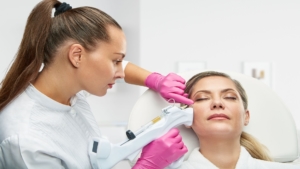How PRP Therapy helps new skin growth.

How PRP Therapy helps new skin growth.
In this era where technology is pushing its limit through groundbreaking discoveries to enhance and improve the lives of the people, it is very evident that even in health and beauty, scientists have found solutions to slow the process of aging, innovative skin treatments, advanced surgical and nonsurgical procedures, cosmetics advancement and discover regenerative processes of healing and wellness. Such discoveries are found to be beneficial, if not eliminate the problem.
PRP THERAPY
One innovative discovery that made a headline is the use of PRP therapy. Autologous conditioned plasma, commonly called Platelet-rich plasma, is a concentrate of platelet-rich plasma protein obtained from whole blood, centrifugalism to remove red blood cells. PRP therapy is a revolutionary natural procedure that rejuvenates our face. Platelet has a significant role in our skin in terms of healing. It promotes blood clotting so our wounds won’t excessively bleed. It contains protein in the blood that helps wounds to heal. As a part of the major blood cells found in our body, platelets help the tissue to heal and stimulate new cell growth. Platelets in our blood contain numerous Platelet Derived Growth Factors (PDGFs) that stimulate growth cels and proliferation of fibroblasts and keratinocytes, which produced collagen and keratin. PDGFs have a significant role in blood vessel formation, the cellular division of fibroblasts, and in synthesizing collagen and the extracellular matrix, including hyaluronic acid.
This procedure is not a surgical facelift. It is performed via the autologous injection of high concentration of platelets in a small volume of plasma. PRP Therapy is commonly used in dermatology and plastic surgery.
SKIN REJUVENATION AND HAIR GROWTH
When the PRP is injected into specific areas of the skin, it acts as a matrix that promotes our own collagen to grow and regenerate tissue as well as speeds up the skin’s repair process promoting smoother, tighter skin, heals dark under eye circles and volume loss, softens wrinkles, creates smooth texture, less scarring, and improved skin tone. Some examples of treatment areas where PRP has been used includes hair growth. By injecting it into the scalp, it reduces the inflammation that can lead to hair loss. Tissue healing helps people heal after jaw and plastic surgeries. It has been successfully used in parts such as tendon, ligament, and muscles. PRP therapy is an attractive option in ligaments for those who have experienced injuries to this tissue group as it takes more time and difficult to heal. Inflammation reduction is another treatment where PRP has been used to reduced inflammation on joints. It is also used to reduced the inflammation caused by osteoarthritis. Other uses include research studies in regrowth cells, reduce knee osteoarthritis pain compared to saline injections and reduce symptoms with the knee injury chronic patellar tendinopathy. As of this time, many doctors are trying to use PRP in healing broken bones, but no available research has yet proven on how effective it is.
WHAT TO EXPECT
PRP therapy uses the body’s own blood to help create newer, healthier skin tissue. Some treatment requires a series of injections, while others use a micro-needling pen. A microneedle pen that is comprised of sterile needle tips needle is used to create controlled microchannels in our skin. This method creates tissue injury which gives an added jump start to the PRP to stimulate tissue repair and growth. Mild swelling and moderate redness will occur. The result varies but the ineffectiveness with this procedure is very minimal and the results are well worth it. The goal of PRP therapy is to improve skin tone and texture, tighten skin, decrease scarring, and soften lines and pores. After treatment, the creation of new skin tissue accelerates. It’s important to remember that although PRP therapy isn’t a permanent solution to the problem of aging skin, it should be performed at regular intervals. PRP therapy promotes new skin growth and can help restore our facial features to a more youthful condition.






